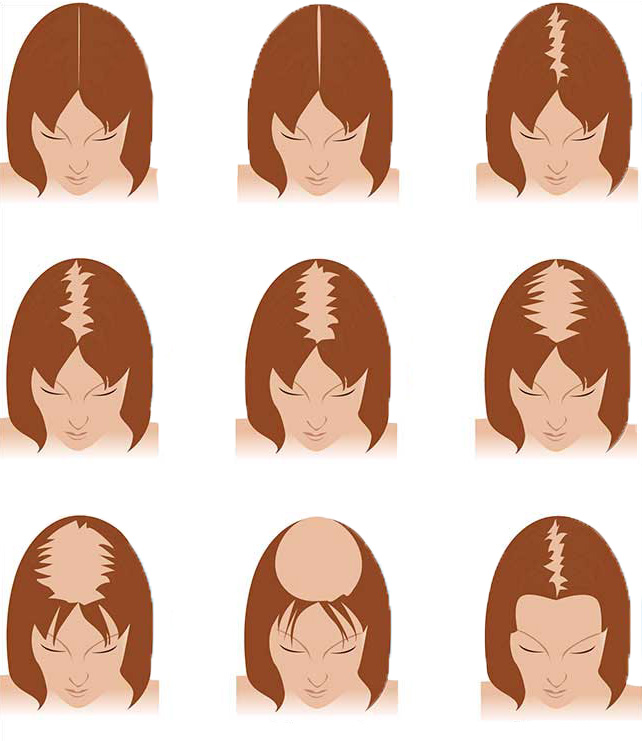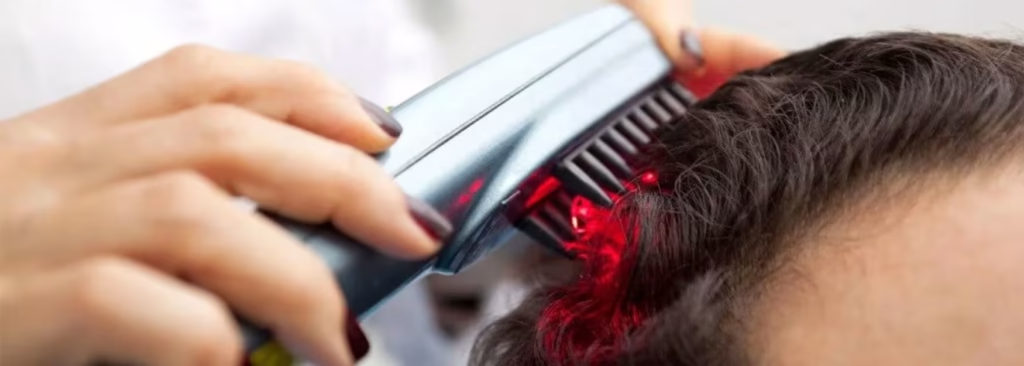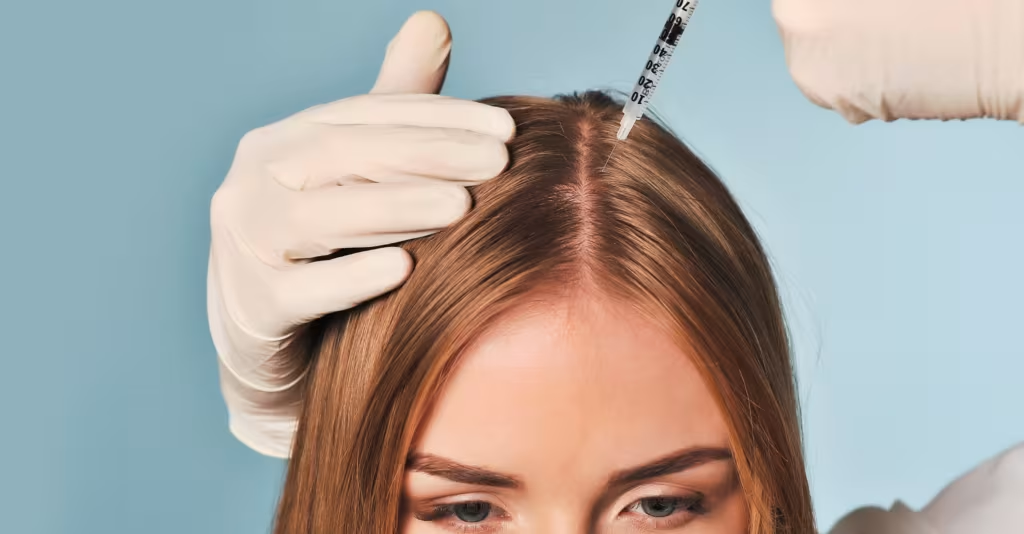Hair loss can be a particularly distressing experience for women in Singapore, affecting not just physical appearance but also emotional well-being and self-confidence.
In Singapore, where lifestyle factors, environmental conditions, and genetic predispositions create unique challenges, understanding the causes and available treatments for female hair loss is crucial.
This comprehensive guide explores everything you need to know about women’s hair loss in Singapore, from identifying the underlying causes to finding the most effective treatments tailored to your specific condition.
Read more: Hair Loss Treatment in Singapore
Understanding Female Hair Loss

Hair loss, medically known as alopecia, refers to the partial or complete absence of hair from areas where it normally grows, particularly the scalp. While commonly associated with men, hair loss affects a significant number of women as well.
Unlike male pattern baldness, which typically results in receding hairlines and complete bald spots, female hair loss usually presents as overall thinning across the crown and top of the head. This diffuse thinning can begin as early as puberty but is most commonly observed after menopause.
Normal hair fall ranges between 100-125 strands per day, which are typically replaced through the natural hair growth cycle. True hair loss occurs when these fallen hairs aren’t regrown or when daily shedding exceeds 125 strands.
This might help: Best Hair Loss Clinic in Singapore
Common Types of Hair Loss in Women
Female Pattern Hair Loss (FPHL)
Previously termed as female androgenetic alopecia, FPHL is the most common type of hair loss in women. Scientists have found that the hormonal factors in women’s hair loss are more complex than in men, which led to the adoption of this more appropriate term.
FPHL is characterized by progressive hair thinning, particularly at the crown of the head. The Ludwig Scale is commonly used to classify the severity of FPHL, progressing from Type 1 (mild) to Type 3 (extensive).
Telogen Effluvium
Telogen effluvium occurs when hair follicles prematurely enter the resting (telogen) phase of the hair growth cycle, resulting in excessive shedding. This condition can be triggered by significant stress, illness, or hormonal fluctuations such as those experienced during pregnancy or menopause.
Unlike FPHL, telogen effluvium typically presents as sudden, often dramatic hair loss, with large amounts of hair falling out during washing or brushing.
Read more: TCM for Hair Loss in Singapore
Alopecia Areata
This autoimmune disorder causes the immune system to mistakenly attack hair follicles, resulting in hair falling out in small, round patches. Alopecia areata can affect any hair-bearing area of the body and may develop suddenly.
Primary Causes of Hair Loss in Women
Several factors can contribute to hair loss in women, often working in combination:
Genetic Predisposition
Family history plays a significant role in female pattern hair loss. If your mother, father, or other close relatives experienced hair loss, you may have a genetic predisposition to it as well.
Hormonal Changes
Various hormonal shifts throughout a woman’s life can trigger or worsen hair loss:
- Pregnancy and Postpartum: The hormonal fluctuations during and after pregnancy can cause temporary hair loss
- Menopause: Declining estrogen levels can lead to thinning hair
- Thyroid Imbalances: Both hypothyroidism and hyperthyroidism can affect hair growth cycles
- Contraceptive Pills: Starting or stopping birth control can trigger hormonal imbalances leading to hair loss
You might like: The Ultimate Guide to Hair Transplants in Singapore
Nutritional Deficiencies
Your diet directly impacts hair health. Deficiencies in key nutrients can contribute to hair loss:
- Insufficient iron
- Low vitamin D levels
- Inadequate zinc
- Lack of essential fatty acids
- General malnutrition or extremely restrictive diets
Stress Factors
High-stress levels elevate cortisol and reduce melatonin, both of which can disrupt normal hair growth cycles.
Chronic stress, traumatic events, or significant lifestyle changes can all contribute to hair loss.
Related article: Which Hair Transplant Clinic in Singapore Should You Consider? (Sort by Reviews)
Medical Conditions and Medications
Certain health conditions and their treatments may cause hair loss.
These include autoimmune disorders, scalp infections, cancer treatments like chemotherapy, and medications for depression, arthritis, heart problems, or high blood pressure.
Signs and Symptoms of Hair Loss in Women
Early detection of hair loss allows for more effective treatment. Watch for these warning signs: gradual thinning that is particularly noticeable at the crown or part line, a gradually widening part in your hair, and increased shedding where you find more hair than usual on your pillow, in the shower drain, or on your hairbrush.
Other concerning signs include increasing visibility of your scalp through your hair, changes in hair texture where hair becomes finer, more brittle, or breaks easily, and slower growth where hair grows more slowly than before.
This might help: FUE Hair Transplant in Singapore: Cost, Reviews, Risks
Non-Surgical Hair Loss Treatments in Singapore
Singapore offers a wide range of non-surgical treatments for female hair loss, each targeting different causes and mechanisms:
Laser Therapy

Low-level laser therapy (LLLT) uses specialized devices to stimulate hair follicles and promote growth. This non-invasive treatment increases blood circulation in the scalp, delivering essential nutrients and oxygen to hair follicles.
Cost: SGD 200-500 per session Availability: Most hair loss treatment clinics in Singapore
Platelet-Rich Plasma (PRP) Therapy
PRP therapy harnesses your body’s natural healing properties to stimulate hair growth. The procedure involves drawing a small amount of your blood, processing it to concentrate the platelets, and injecting the PRP directly into your scalp.
The growth factors in platelets can trigger hair follicle activity, helping to increase hair count and thickness.
The cost ranges from SGD 500-1,500 per session and is available at specialized medical clinics.
Topical Medications
Minoxidil (commonly known by the brand name Rogaine) is the most widely used topical treatment for female hair loss. Applied directly to the scalp, it improves blood flow to hair follicles and extends the growth phase of hair.
Cost: SGD 50-100 per month Availability: Pharmacies and medical clinics
Oral Medications
Several oral medications can help address hormonal causes of hair loss in women:
Spironolactone: Blocks androgen receptors and reduces hormone levels contributing to hair loss
Finasteride: Though primarily prescribed for men, it may be used off-label for post-menopausal women under careful medical supervision
Cost: SGD 60-150 per month Availability: Prescription through medical clinics
Regenera Activa

This innovative treatment involves using micrografts obtained from your own scalp to rejuvenate hair follicles. The procedure is minimally invasive and can be integrated with other therapies for enhanced effectiveness.
Cost: Around SGD 2,300 per session Availability: Specialized hair restoration clinics
Read more: Regenera Activa Singapore: Benefits, Risks, Costs
RF Gold Microneedling
This treatment combines microneedling with radiofrequency energy to stimulate the scalp and promote hair growth. The dual action helps revitalize dormant hair follicles.
Cost: From SGD 500 per session Availability: Most aesthetic and hair loss clinics
Hair Loss Supplements
Specialized supplements containing nutrients essential for hair growth can support overall hair health.
Common ingredients include biotin, iron, zinc, saw palmetto, and marine proteins as found in brands like Nourkrin and Miriqa.
These supplements cost from SGD 158 and are available at pharmacies and medical clinics.
Surgical Options for Hair Loss
Hair Transplantation
For women with significant hair loss, hair transplantation may be an effective solution. This surgical procedure moves hair follicles from a donor site (usually the back of the head) to areas experiencing thinning or baldness.
Modern techniques like Follicular Unit Extraction (FUE) allow for natural-looking results with minimal scarring.
Cost in Singapore:
- Head (with shaving): From SGD 4 per graft
- Head (without shaving): From SGD 6 per graft
- Eyebrows and other facial regions: From SGD 8 per graft
Choosing the Right Hair Loss Treatment in Singapore
Selecting the most appropriate treatment depends on several factors:
1. Proper Diagnosis
A comprehensive consultation with a hair loss specialist is essential for accurate diagnosis.
This typically includes a detailed medical history, physical examination of the scalp, tests for hair breakage, assessment of the percentage of hair follicles in the resting or shedding phase, and blood tests to identify hormonal, nutritional, or metabolic factors.
2. Treatment Plan Customization
Based on your diagnosis, a specialist will recommend a personalized treatment plan that may combine multiple approaches for optimal results.
3. Clinic Selection
Look for clinics with experienced dermatologists or trichologists, comprehensive evaluation processes, modern treatment technologies, positive patient reviews, and clear pricing structures.
Preventing Hair Loss in Women
While some causes of hair loss cannot be prevented, these strategies can help maintain hair health and minimize loss:
Nutrition and Diet
Maintain a balanced diet rich in protein, which is essential for hair structure, iron to prevent anemia-related hair loss, omega-3 fatty acids to support scalp health, vitamins A, C, D, and E to promote healthy hair growth, and zinc and selenium to support hair structure.
Avoid crash diets or extreme calorie restriction, which can trigger telogen effluvium.
Gentle Hair Care
Use mild, sulfate-free shampoos and conditioners, and avoid tight hairstyles that pull on hair follicles.
Minimize use of heat styling tools and allow hair to air dry when possible. Use wide-toothed combs to prevent breakage and avoid chemical treatments when possible.
Stress Management
Incorporate stress-reduction techniques into your routine including regular exercise, meditation or mindfulness practices, adequate sleep, work-life balance, and professional counseling if needed.
Regular Scalp Care
Maintain scalp health through scalp massages to stimulate blood flow, scalp exfoliation to remove dead skin cells, protection from sun damage with hats or SPF products, and proper hydration both internal and external.
FAQ About Women’s Hair Loss in Singapore
How is female hair loss different from male hair loss?
Female pattern hair loss typically presents as diffuse thinning across the crown without major receding of the hairline.
The hair gradually becomes finer and the part widens, but complete baldness is rare.
In contrast, male pattern baldness usually begins with a receding hairline and vertex thinning, often progressing to complete baldness in affected areas.
The hormonal mechanisms also differ significantly. While male pattern baldness is strongly linked to DHT (dihydrotestosterone), female pattern hair loss has more complex and varied hormonal influences.
Women with normal hormone levels may still experience hair loss, indicating that other factors play important roles.
How long do hair loss treatments take to show results?
Results vary significantly depending on the treatment type and individual factors.
Topical treatments like minoxidil typically take 3-6 months to show noticeable improvement, while laser therapy may require 2-4 months of regular sessions.
PRP therapy often requires 3-4 sessions spaced 4-6 weeks apart before results become visible, and oral medications may take 3-12 months to demonstrate effectiveness.
Hair transplantation results begin to appear after 3-4 months, with full results visible after 12-18 months.
Consistency is crucial for optimal outcomes with any treatment approach, and most treatments require maintenance to sustain results.
Can pregnancy-related hair loss be treated?
Postpartum hair loss (telogen effluvium) is typically temporary and resolves on its own within 6-12 months after childbirth as hormone levels stabilize.
However, certain treatments can help manage symptoms and promote recovery, including a nutrient-rich diet and supplements particularly iron, vitamin D, and biotin, gentle hair care practices, and scalp treatments to stimulate blood flow.
It’s important to note that many hair loss treatments are not recommended during pregnancy or while breastfeeding.
Always consult with a healthcare provider before starting any treatment during these periods.
What are the side effects of hair loss treatments?
Side effects vary depending on the treatment. Topical treatments may cause scalp irritation, itching, or dryness, while oral medications can have potential side effects including hormonal changes, digestive issues, and for some medications like finasteride, sexual side effects primarily in men.
PRP therapy may cause temporary soreness, redness, or swelling at injection sites, while laser therapy generally has minimal side effects with occasionally mild scalp irritation.
Hair transplantation can result in temporary swelling, discomfort, and in rare cases, infection or scarring. Always discuss potential side effects with your healthcare provider before starting any treatment.
Are hair loss treatments safe for all hair types?
While hair loss treatments target common underlying causes, their suitability and effectiveness can vary based on hair type, texture, and ethnicity.
Asian hair, which is common in Singapore, has specific characteristics that may respond differently to certain treatments.
Most non-surgical treatments are generally safe for all hair types, but outcomes may vary.
A personalized consultation with a specialist is essential to determine the most appropriate treatment approach for your specific hair type and condition.
How can I prevent hair loss while using hair styling products?
To minimize hair damage from styling products and routines, choose gentle, alcohol-free products specifically formulated for your hair type.
Avoid products containing harsh chemicals like sulfates and parabens, and apply heat protectant sprays before using hot styling tools.
Reduce the frequency of chemical treatments such as coloring, perming, or relaxing, and avoid tight hairstyles that pull on the hair.
Allow your hair to “rest” from styling regularly and remove styling products completely with gentle cleansing.
What role does nutrition play in hair loss?
Nutrition significantly impacts hair health. Key nutrients for preventing hair loss include:
- Protein: The primary building block of hair
- Iron: Essential for carrying oxygen to hair follicles
- Zinc: Supports hair tissue growth and repair
- Vitamin D: Helps create new follicles
- B vitamins: Especially biotin, which promotes keratin production
- Omega-3 fatty acids: Reduce inflammation and support scalp health
- Vitamin E: Provides antioxidant protection for hair follicles
- Vitamin C: Aids iron absorption and collagen production
Nutritional deficiencies, particularly of iron and protein, are common contributors to hair loss in women.
Blood tests can identify specific deficiencies that may be addressed through diet or supplementation.
How do hormonal changes during menopause affect hair loss?
Menopause brings significant hormonal shifts that can impact hair growth:
Relative increase in androgens: With lower estrogen, the impact of androgens (male hormones) becomes more pronounced, potentially triggering or worsening female pattern hair loss
Thyroid changes: Menopausal women are at higher risk for thyroid disorders, which can contribute to hair loss
Treatment approaches for menopausal hair loss often include hormone-balancing medications alongside traditional hair loss treatments.
Regular thyroid function testing is also recommended.
What is the cost of hair loss treatment in Singapore?
Treatment costs in Singapore vary widely:
| Treatment Type | Cost Range |
|---|---|
| Laser Therapy | SGD 200-500 per session |
| PRP Therapy | SGD 500-1,500 per session |
| Topical Medications | SGD 50-100 per month |
| Oral Medications | SGD 60-150 per month |
| Hair Supplements | From SGD 158 |
| Regenera Activa | From SGD 2,300 per session |
| RF Gold Microneedling | From SGD 500 per session |
| FUE Hair Transplant | From SGD 4-8 per graft |
Most clinics offer consultation services to provide more accurate cost estimates based on individual needs and treatment plans.
Can stress really cause hair loss?
Yes, stress is a significant contributor to hair loss, particularly telogen effluvium. Stress impacts hair growth through multiple mechanisms:
Elevated cortisol levels: Chronic stress increases cortisol, which can prematurely push hair follicles into the resting phase
Reduced blood flow: Stress can constrict blood vessels, limiting nutrient delivery to hair follicles
Disrupted sleep patterns: Stress-related sleep disturbances can impair cellular repair and regeneration
Hormonal imbalances: Stress can trigger or exacerbate hormonal fluctuations that contribute to hair loss
Scalp tension: Physical manifestations of stress can create scalp tension that impairs follicle function
Stress management techniques, including meditation, regular exercise, adequate sleep, and in some cases, professional counseling, can help mitigate stress-related hair loss.
Conclusion
Hair loss in women is a complex issue influenced by genetics, hormones, lifestyle factors, and medical conditions.
Understanding the specific cause of your hair loss is essential for effective treatment.
Singapore offers a comprehensive range of treatment options, from non-invasive approaches like laser therapy and topical medications to more advanced solutions like PRP therapy and hair transplantation.
With proper diagnosis and customized treatment plans, many women can successfully address hair loss and restore both their hair and confidence.
If you’re experiencing hair loss, consult with a qualified specialist who can provide personalized advice based on your specific condition.
Remember that early intervention typically leads to better outcomes, so don’t delay seeking professional guidance if you notice signs of excessive hair loss.

